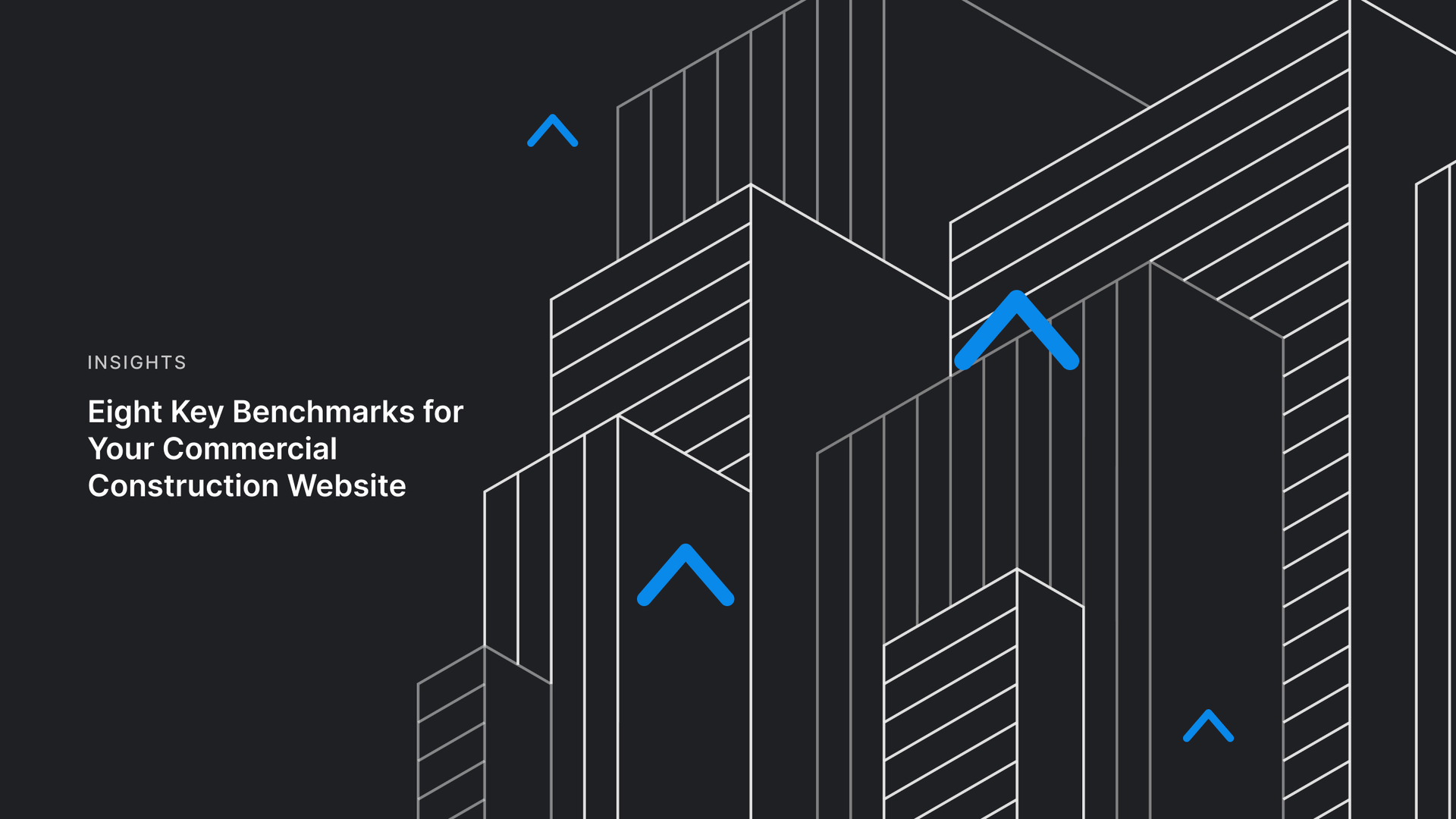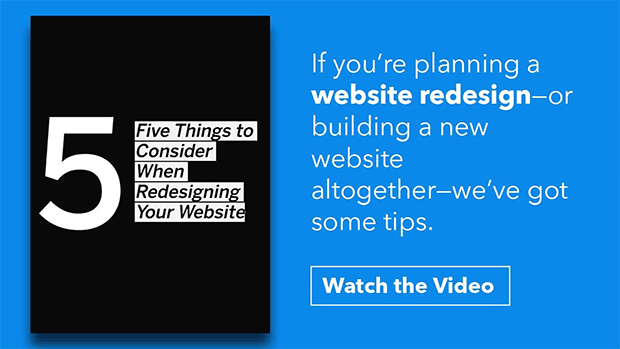Eight Key Benchmarks for Your Commercial Construction Website
If you’re in the commercial construction industry, it’s unlikely someone is going to hire you based solely on a visit to your website.
That’s bold talk from a construction website design firm, isn’t it? But it’s true.
This is a relationship- and referral-driven industry. Eighty percent of your business—maybe more, that’s just the industry average—likely comes from repeat clients or client referrals
For this reason, websites are often overlooked as part of the sales process.
Even so, your construction website still plays an indispensable role in your business development process, even if it’s not a primary lead generator.
Build to inform, inspire and reassure. And then some.
Commercial construction websites have a lot of jobs to fill.
Your current customers might refer colleagues to your site for confirmation of your expertise and fit for a potential project. Subcontractors will explore potential partnerships. Craft labor, management and corporate employee candidates will visit your site to decide if you match their career dreams. And yes, many prospects might use Google to find your company and start a relationship from scratch.
If it’s like a lot of commercial construction websites, your site probably has some photos of your past projects, technical descriptions of projects, and a page for each service you offer. But does it inform people about who you are and how you’re different? Does it inspire them to trust you more than any other AEC partner? And finally—maybe most importantly—does it reassure them that you’re up to solve whatever challenges they can bring you?
Inform, inspire, reassure. These are three big goals. But how do you get there?
Here are six questions to get you started.
Benchmark #1: Is your site built around owner or decision-maker needs?
It’s the most important question you can ask as you build your website, or any marketing materials you create: Who’s your audience?
Are you talking to property developers, who may be looking for a design-build partner? Business owners looking to expand, add a new location or build on to an existing one? Do your clients work in industries like healthcare, or maybe municipalities or government agencies?
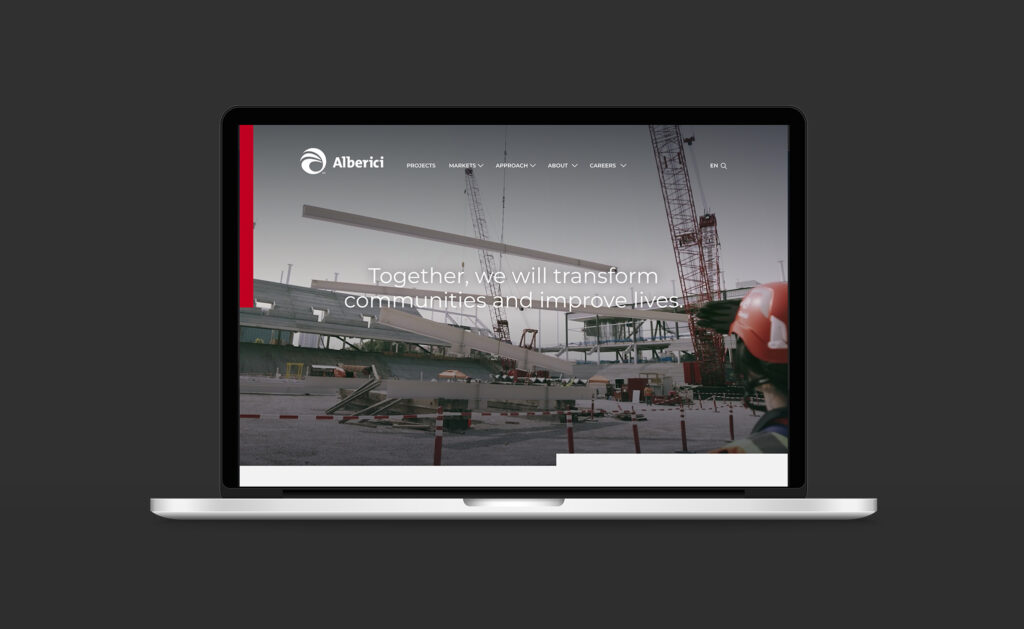 Above, the Alberici website addresses the audience’s needs and pain points.
Above, the Alberici website addresses the audience’s needs and pain points.
Whatever your answer is, it should be used to guide you as you organize and create content for your site.
For example, while there’s a fairly standard list of pages or sections you should have on your site, how you organize them—and what you ask people to do next—will vary, depending on who you’re talking to, their unique needs and where they are in the decision-making process.
The goal is to show that you share their values and priorities. Note that these aren’t your organization’s “core values.” Those are important, and guide what you do every day, internally. But your potential clients want to know you care about the same things they do, from the practical to the technical. Again, the softer, more emotional benefits inherent in core values are part of the story. But they’re not the story.
For example, if you’re talking to property developers, you might want to focus on scalability and on-time project delivery. Business owners will want to know you have experience working with local permitting and building the kinds of spaces that meet their customer and employee needs. Similarly, healthcare clients will look for very specific points you can make about building for the healthcare market, including technology integration, accessibility, speed of delivery and more.
When you align the content of your commercial construction website with what your specific audience cares about, you’re that much closer to a win.
Lead prospects to the next step, based on where they are now.
In addition to understanding your clients’ industries and what’s important to them, it’s critical to demonstrate an understanding of where they are in the construction process. Then you need to create content that helps them move forward.
If you know you’re talking to developers early in the planning process, you can tout your design-build expertise. If they’re hung up on scheduling and billing, maybe a focus on pre-construction is appropriate. Are they dealing with projects stalled by permitting? Tout your consultive ability to get projects back on track. The goal is for your prospects to see themselves in your solutions so they’ll remember you when they need you most.
Benchmark #2: Do you give prospects the opportunity to convert?
Many construction websites skip one of the most important steps: inviting potential clients to get to know you better.
Of course, this isn’t Amazon. There’s no “Buy now!” button for people to start drawing up plans tomorrow based on a web form. But encouraging prospects to engage with your construction company is a powerful way to start building a relationship in this relationship-based industry.
How do you get people to convert? With simple, clear calls to action that let them know what’s going to happen next. Each phase of conversion can involve varying levels of commitment from your audience—levels you can customize based on where prospects are in the buying process, and how it aligns with your firm’s business development process.

Above, calls to action on the ARCO Construction website.
Calls to action should be included throughout your site—not just on the contact page. The best construction websites have a range of conversion opportunities:
A newsletter signup is a direct invitation to get relevant info right in their inbox. Your call to action here could invite website visitors to “Get updates on our latest projects” or, “Keep up with our latest industry insights.”
Some visitors might not want to give away their contact information, though, so consider inviting them to follow your company on your social media pages.
If your industry supports it, it may be appropriate to have a more direct call to action, inviting prospective clients to “Schedule a meeting” or “Book a consultation.”
Websites for general contractors often also include forms for subcontractors to be considered for bid submissions.
So, what happens once they’ve “converted”? However you define it, the next most important step is ensuring you have a system to follow up with leads. Ideally, that includes a customer relationship platform like HubSpot that makes it easy to keep track of prospects, where they come from and who’s responsible for following up.
Most customer relationship tools can also automate the follow-up process. This should also be a critical part of your construction website planning process.
Benchmark #3: Are you emphasizing how you’re different from competitors?
Most AEC and commercial construction companies bring a similar set of services to the table. These alone don’t help you stand out. And you certainly don’t want to stand out by giving these services unique, branded names, because then you have to spend too much time explaining what they are.
Maybe your firm has comprehensive design-build processes, award-winning design teams or advanced virtual design tools. Maybe you specialize in especially complex construction projects, with in-house manufacturing and fabrication. Perhaps you have a regional focus—or an ability to serve a growing multinational company’s global construction needs.
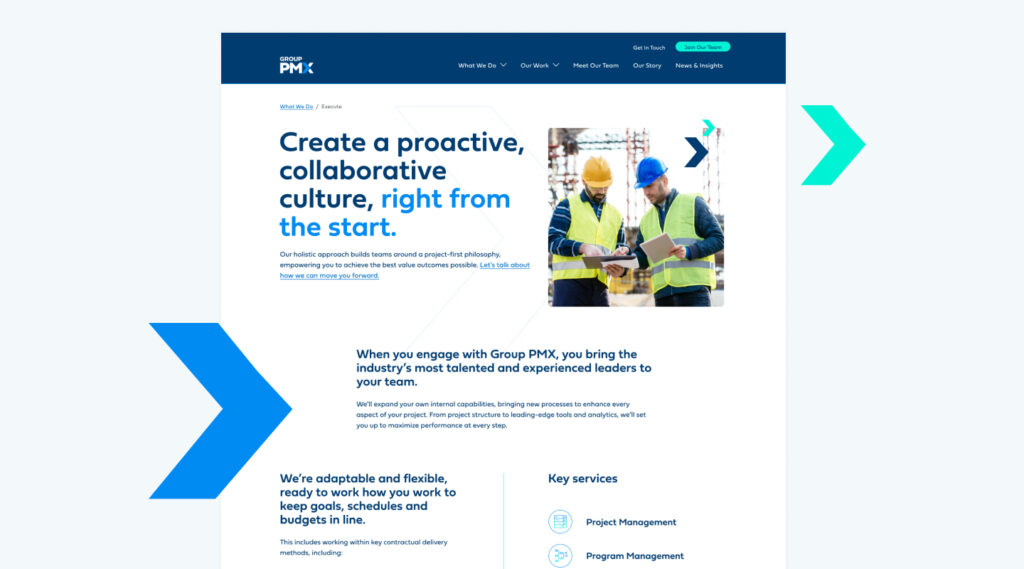
Above, the website for Group PMX, a construction project management firm, explains how the company’s processes, team and technology set customers up for success.
There’s a tendency in the construction industry to spend a lot of time defining services. And while there may be a need to set the stage, you probably don’t need to specifically explain pre-construction, for example. Instead, spend the valuable real state on your website to talk about your company’s approach to pre-construction, and how it benefits clients. Include examples of work and, if appropriate, key company leaders who potential customers may encounter during the pre-construction process.
The goal is to give people a reason to choose you—and that means standing out. Rising above textbook definitions of processes to show how your approach leads to successful project delivery is the best way to connect with prospects and inspire them to trust your team.
Benchmark #4: Are you using testimonials and social proof to bolster your credibility?
Especially in this relationship-driven business, people want to know what it’s like to work with your construction business. Perhaps an industry colleague told them how great it is to work with you, and they’re looking for—here’s that word again—reassurance that what they’ve heard is true.
Customer testimonials play a powerful role in winning business: 88% of customers see testimonials as being “as trustworthy as family.” And testimonials have been shown to increase traffic by as much as 45% compared to sites that don’t feature them.
Why are testimonials so effective? It’s simple: it’s far more powerful to hear someone else’s words singing your praises than your own.
Of course, especially with larger firms, sometimes testimonials can be difficult to come by. That’s okay. If your clients are fine with it, you can still anonymize them, attributed to “major retailer” or “leading midwest hospital system.”
Don’t relegate client quotes to a single “testimonials” page. Find ways to incorporate testimonials onto every page of your site, from the home page to services section and, of course, your relevant project pages. With a bit of creativity, they can even become visually appealing design elements that keep users scrolling through your site.
Benchmark #5: Is your site supporting your recruitment efforts?
The labor market is tough, both for job seekers and construction firms alike. It’s harder than ever to find qualified candidates, at both the skilled labor and corporate levels.
Today’s job seekers are looking for more than a job—ESG and DEI initiatives have been part of recruitment pages for decades, and they’re still just as important.
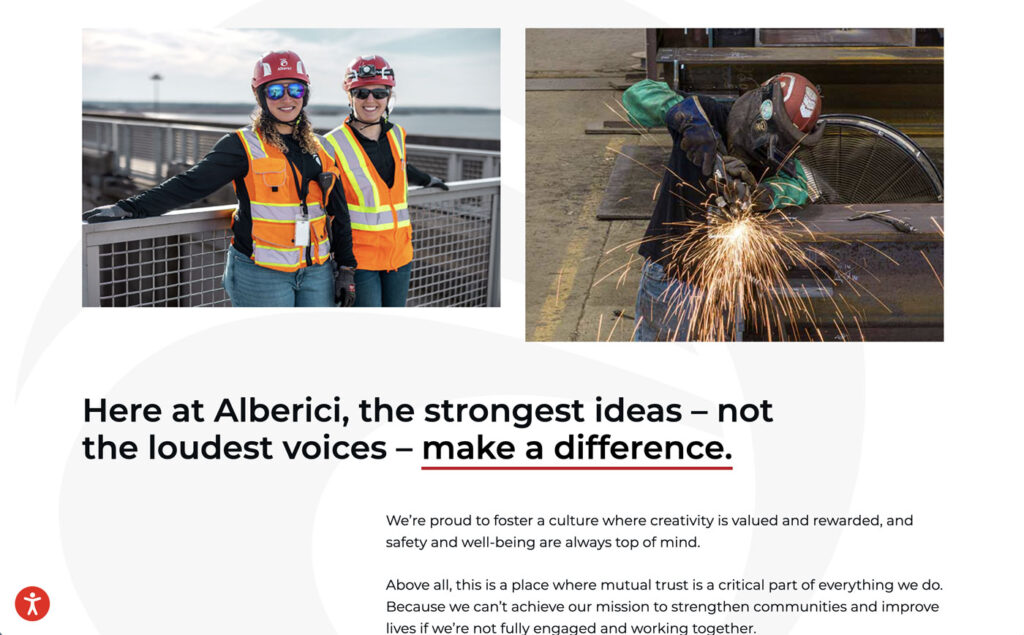
Above, the Alberici website Careers page gives visitors a glimpse of life inside the company.
Even more so, candidates aren’t just looking for job listings. They’re looking for what truly makes you different: Your culture. Shared values. Community commitment.
And yes, alongside all those soft factors, they’re looking to know about the kinds of projects they’ll be able to build. Just like on the business development side, this is a great chance to incorporate employee testimonials to show that the claims you’re making are real.
Explore our architecture, construction and real estate website design work.
Benchmark #6: Does your site look modern and engaging?
Let’s face it: first impressions matter. When potential clients land on your site, you want them to be as impressed as they would be walking into a finished project.
Visuals and aesthetics might seem like fluff, but they can have a huge impact: Your color palette should reflect your brand colors and elicit trust, while also maintaining accessibility standards. And make sure your site features your best commercial builds with high-quality photos, videos and case studies showcasing the scale, complexity and precision of your projects.
Benchmark #7: Are you ranking for your most important keywords?
Even prospects who know your brand may not come directly to your site. Those prospects—and potential clients who are unaware of your brand but looking for a solution to their problem—will likely turn to Google. If your website isn’t showing up high in the results, your company will miss out.
Tools like Ahrefs or Semrush (with both paid and free functionalities) can help you identify keywords people are using to find construction company websites. You can export lists of top keywords and key phrases and gain some insight into how competitive it will be to rank for specific keywords. In highly competitive markets, these tools will also suggest alternative phrases that may better fit your content and make it easier for you to earn a higher ranking.
It’s important not to think of your site as a book people are going to read cover to cover. You can’t assume people are going to always come to your website through the home page and then go directly a service or industry page. If you play your search cards right, you can guide visitors directly to an industry page or blog post that speaks to their specific needs.
The best course of action is to select one to two target keywords for each of the important pages of your website. Your homepage might target a broad phrase. For example, if you’re regionally focused, maybe “commercial construction st. louis.” Services pages could be optimized around design-build or specific industries.
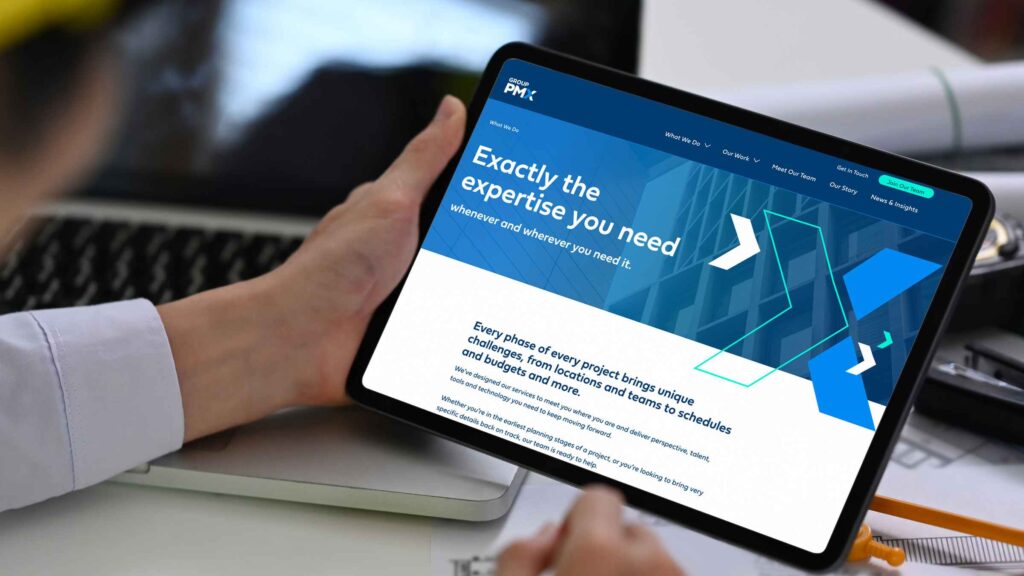
Above, pages on the Group PMX website are optimized to target specific keywords
As you get more and more specific with keyword research, there’s one more factor to consider: search intent. For example, someone searching for a specific medical center may be looking for care, or even for directions to the hospital, rather than the construction partner who built the hospital. Be sure to prioritize keywords that will be relevant to your audience at the right time. Instead of the name of the hospital, you’ll probably want to focus on the keywords around the technologies, processes or delivery methods you used.
For the most part, measuring “search intent” will be a matter of trial and error. Search for your key target terms, and study the results. Adjust the terms as necessary to discover the most relevant terms for each page.
See this in action by comparing the search results for “design-build” with “design-build construction” and “design-build delivery method.” You may be surprised.
Note that many of the top search results for construction terms like preconstruction or construction management are often detail- and keyword-rich academic articles. These will be hard to beat with your commercial construction site—another vote in the column of talking about how you’re different, not simply defining a term.
Are you using the right keywords on your website?
In the early days of search engine optimization, “keyword stuffing” was the rule—simply using keywords more often on a page would ensure a higher ranking.
Today, Google and other search engines see through this nonsense, instead looking to other factors to determine the relevance of your content to each keyword. The goal is to improve the relevance of search results. It’s also to improve the user experience; after all, you don’t want someone to land on your page and have a terrible experience because you’ve written your page more for Google than for your audience.
Of course, the best way to rank for a term is to use it, responsibly, on your page. Study the variations of the phrase. Pay attention to search intent and context. But of course, there’s more, and this is where we start to get a little more technical.
Benchmark #8: Is your domain rating increasing steadily?
SEO and web design nerds, this is your time to shine. We’re digging into the technical aspects of your website’s performance now. So sit back as we dig into “domain rating.”
Every website on the internet has a domain rating—a number that represents how much your site delivers value and can be trusted.
It’s based on a several factors—primarily how many other sites link to your content and the trustworthiness and authority of those sites. As a general rule, sites with higher domain ratings rank higher in search, and that can have a huge impact on your business.
There are several obvious and not-so-obvious ways to improve your domain rating. The best part? You don’t have to do all of these all at once. As you build and enhance your site over time, your continued attention to these factors will ensure your score continues to increase. And the fact that your score is increasing, especially relative to your competitors, is far more important than the score itself.
Create a robust internal linking structure.
Internal links lead visitors from one page of your site to another. This creates an engaging user experience (UX), ensuring no page is a dead end.
Easy navigation is important for both UX and SEO. As visitors navigate deeper into your site, be sure to use breadcrumbs to help them find their way back out. This gives your site a logical structure, which both improves the user experience and makes it easier for search engines to index and prioritize pages. Most content management systems, like WordPress, include built-in or plugin functionality to bring effective breadcrumb navigation to your site.
Decrease load speed.
One of the factors Google uses to determine rank order is the amount of time a website’s pages takes to load. Every millisecond counts. In 2023, 83% of users expected a webpage to load in three seconds or less—and more than 40% will leave if that doesn’t happen.
Faster-loading pages deliver a better experience. Google knows this, so faster-loading pages rank higher.
How do you improve your page speed? There are many factors to consider.
First, check your image sizes, and use modern image formats like WebP that maintain quality while keeping the size of even large background images and other high-quality images manageable.

Above, a microsite built for McCarthy Building Companies is optimized for fast page load speed.
Second, reduce the number of HTTP requests your visitor’s browser has to make to load each page. For example, each website contains CSS (cascading style sheet) files that dictate how the page looks, and Javascript files that dictate how it works. There can be multiple files for each page, which slows down the load time. Combining these minimizes the number of separate requests, and ensures your page loads faster.
Next up, use browser caching to improve your site’s performance. This means including code on your site that allows files—like the aforementioned CSS or Javascript—to be stored either locally on visitors’ computers or on intermediate servers. This can dramatically speed up page load times.
Improve your performance on mobile devices, too.
A great website in 2024 means a lot more than creating for one or two screen sizes. It’s about ensuring your site is user friendly across devices, from a desktop computer to phone or tablet.
Responsive design makes a website mobile friendly, so your site’s content works on any size screen. Modern techniques can stack, reflow or even simplify content so it works on a taller, narrower phone, or bring in other elements for wider, larger tablet and desktop screens.
Get people on other sites talking to build backlinks.
Another important way to build your domain ranking is to build backlinks—links from another website to a page or piece of content on your site.
Why are backlinks important? What’s more powerful: what you say about yourself, or what other respected professionals say? If industry authorities are sharing your content or singing your praises, that carries a lot of weight with Google, and is one of the most important aspects in determining domain rating.
There are a lot of strategies to generating backlinks, but it can happen naturally as a result of what we’ve already covered: Creating content that’s relevant to your audiences. Using words that your prospects use to search for new partners. Demonstrating your expertise.
Beyond that, you can encourage your company’s thought leaders to participate in industry forums and discussions. Sponsor workshops and seminars. Share case studies, blog posts and white papers on social media and industry sites. Create guides that help people do their jobs better. Report on industry trends for key publications.
All of these activities position your firm as an expert, and encourage other sources to link back to your site. This approach organically increases your domain authority and drives traffic to your site.
Keep building, refining and engaging.
Just like with a physical structure, building a construction company website isn’t a one-and-done task. It’s an ongoing effort to find new ways to engage your audience and encourage them to interact with your company.
While your website is is probably just one touchpoint of many, it holds a lot of power—informing, inspiring and reassuring your customers around the world and around the clock. Don’t forget to continuously evaluate it and find ways to make it better.
